Mark Boss
MARBLE: Material Recomposition and Blending in CLIP-Space
Jun 05, 2025



Abstract:Editing materials of objects in images based on exemplar images is an active area of research in computer vision and graphics. We propose MARBLE, a method for performing material blending and recomposing fine-grained material properties by finding material embeddings in CLIP-space and using that to control pre-trained text-to-image models. We improve exemplar-based material editing by finding a block in the denoising UNet responsible for material attribution. Given two material exemplar-images, we find directions in the CLIP-space for blending the materials. Further, we can achieve parametric control over fine-grained material attributes such as roughness, metallic, transparency, and glow using a shallow network to predict the direction for the desired material attribute change. We perform qualitative and quantitative analysis to demonstrate the efficacy of our proposed method. We also present the ability of our method to perform multiple edits in a single forward pass and applicability to painting. Project Page: https://marblecontrol.github.io/
Stable Virtual Camera: Generative View Synthesis with Diffusion Models
Mar 18, 2025Abstract:We present Stable Virtual Camera (Seva), a generalist diffusion model that creates novel views of a scene, given any number of input views and target cameras. Existing works struggle to generate either large viewpoint changes or temporally smooth samples, while relying on specific task configurations. Our approach overcomes these limitations through simple model design, optimized training recipe, and flexible sampling strategy that generalize across view synthesis tasks at test time. As a result, our samples maintain high consistency without requiring additional 3D representation-based distillation, thus streamlining view synthesis in the wild. Furthermore, we show that our method can generate high-quality videos lasting up to half a minute with seamless loop closure. Extensive benchmarking demonstrates that Seva outperforms existing methods across different datasets and settings.
SPAR3D: Stable Point-Aware Reconstruction of 3D Objects from Single Images
Jan 08, 2025



Abstract:We study the problem of single-image 3D object reconstruction. Recent works have diverged into two directions: regression-based modeling and generative modeling. Regression methods efficiently infer visible surfaces, but struggle with occluded regions. Generative methods handle uncertain regions better by modeling distributions, but are computationally expensive and the generation is often misaligned with visible surfaces. In this paper, we present SPAR3D, a novel two-stage approach aiming to take the best of both directions. The first stage of SPAR3D generates sparse 3D point clouds using a lightweight point diffusion model, which has a fast sampling speed. The second stage uses both the sampled point cloud and the input image to create highly detailed meshes. Our two-stage design enables probabilistic modeling of the ill-posed single-image 3D task while maintaining high computational efficiency and great output fidelity. Using point clouds as an intermediate representation further allows for interactive user edits. Evaluated on diverse datasets, SPAR3D demonstrates superior performance over previous state-of-the-art methods, at an inference speed of 0.7 seconds. Project page with code and model: https://spar3d.github.io
SF3D: Stable Fast 3D Mesh Reconstruction with UV-unwrapping and Illumination Disentanglement
Aug 01, 2024
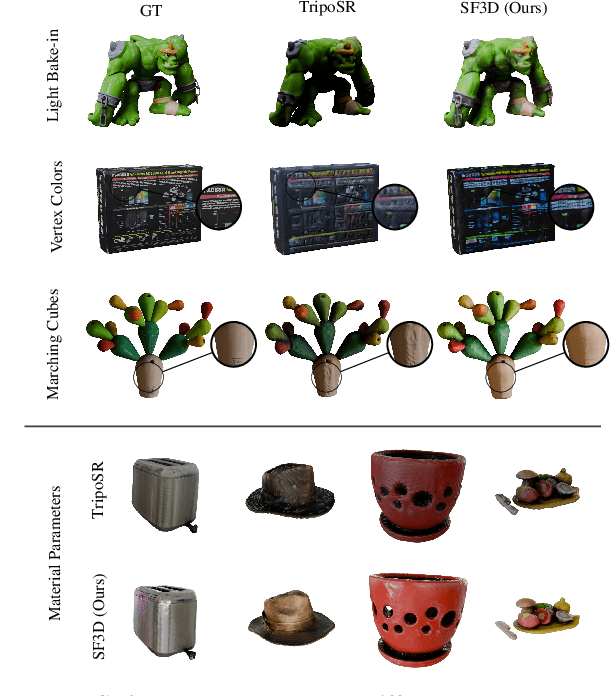

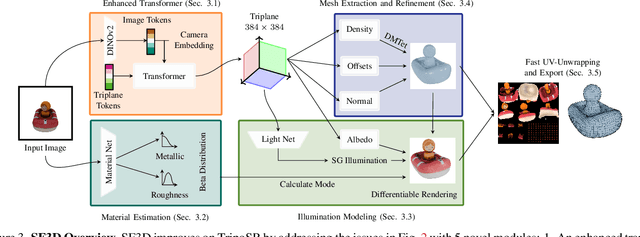
Abstract:We present SF3D, a novel method for rapid and high-quality textured object mesh reconstruction from a single image in just 0.5 seconds. Unlike most existing approaches, SF3D is explicitly trained for mesh generation, incorporating a fast UV unwrapping technique that enables swift texture generation rather than relying on vertex colors. The method also learns to predict material parameters and normal maps to enhance the visual quality of the reconstructed 3D meshes. Furthermore, SF3D integrates a delighting step to effectively remove low-frequency illumination effects, ensuring that the reconstructed meshes can be easily used in novel illumination conditions. Experiments demonstrate the superior performance of SF3D over the existing techniques. Project page: https://stable-fast-3d.github.io
SV3D: Novel Multi-view Synthesis and 3D Generation from a Single Image using Latent Video Diffusion
Mar 18, 2024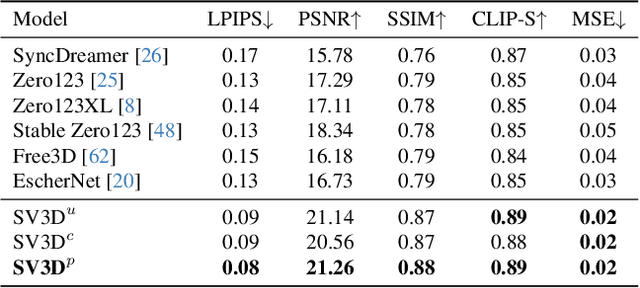
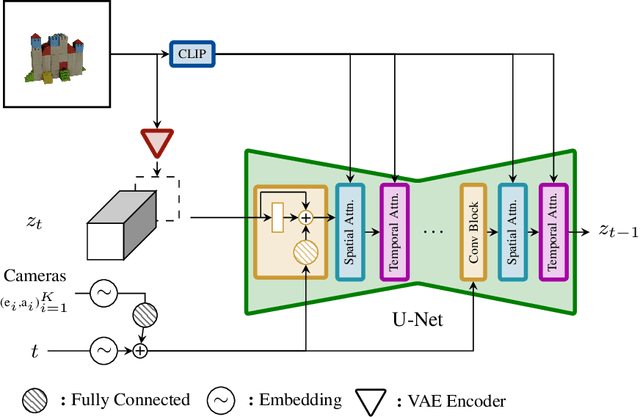
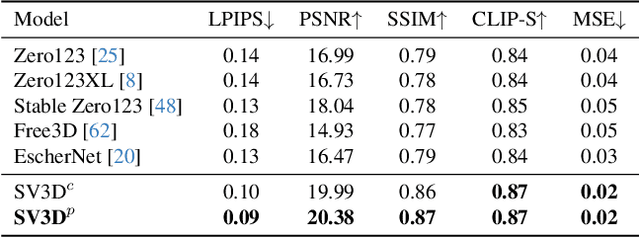
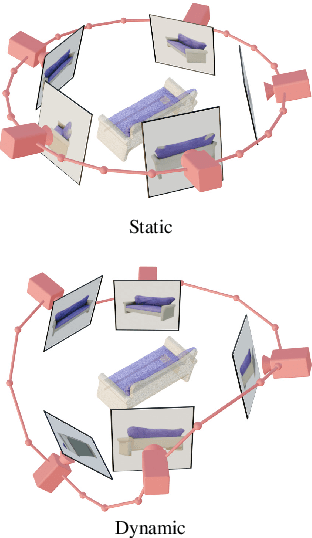
Abstract:We present Stable Video 3D (SV3D) -- a latent video diffusion model for high-resolution, image-to-multi-view generation of orbital videos around a 3D object. Recent work on 3D generation propose techniques to adapt 2D generative models for novel view synthesis (NVS) and 3D optimization. However, these methods have several disadvantages due to either limited views or inconsistent NVS, thereby affecting the performance of 3D object generation. In this work, we propose SV3D that adapts image-to-video diffusion model for novel multi-view synthesis and 3D generation, thereby leveraging the generalization and multi-view consistency of the video models, while further adding explicit camera control for NVS. We also propose improved 3D optimization techniques to use SV3D and its NVS outputs for image-to-3D generation. Extensive experimental results on multiple datasets with 2D and 3D metrics as well as user study demonstrate SV3D's state-of-the-art performance on NVS as well as 3D reconstruction compared to prior works.
Collaborative Control for Geometry-Conditioned PBR Image Generation
Feb 20, 2024Abstract:Current 3D content generation approaches build on diffusion models that output RGB images. Modern graphics pipelines, however, require physically-based rendering (PBR) material properties. We propose to model the PBR image distribution directly, avoiding photometric inaccuracies in RGB generation and the inherent ambiguity in extracting PBR from RGB. Existing paradigms for cross-modal fine-tuning are not suited for PBR generation due to both a lack of data and the high dimensionality of the output modalities: we overcome both challenges by retaining a frozen RGB model and tightly linking a newly trained PBR model using a novel cross-network communication paradigm. As the base RGB model is fully frozen, the proposed method does not risk catastrophic forgetting during fine-tuning and remains compatible with techniques such as IPAdapter pretrained for the base RGB model. We validate our design choices, robustness to data sparsity, and compare against existing paradigms with an extensive experimental section.
SHINOBI: Shape and Illumination using Neural Object Decomposition via BRDF Optimization In-the-wild
Jan 18, 2024Abstract:We present SHINOBI, an end-to-end framework for the reconstruction of shape, material, and illumination from object images captured with varying lighting, pose, and background. Inverse rendering of an object based on unconstrained image collections is a long-standing challenge in computer vision and graphics and requires a joint optimization over shape, radiance, and pose. We show that an implicit shape representation based on a multi-resolution hash encoding enables faster and robust shape reconstruction with joint camera alignment optimization that outperforms prior work. Further, to enable the editing of illumination and object reflectance (i.e. material) we jointly optimize BRDF and illumination together with the object's shape. Our method is class-agnostic and works on in-the-wild image collections of objects to produce relightable 3D assets for several use cases such as AR/VR, movies, games, etc. Project page: https://shinobi.aengelhardt.com Video: https://www.youtube.com/watch?v=iFENQ6AcYd8&feature=youtu.be
SAMURAI: Shape And Material from Unconstrained Real-world Arbitrary Image collections
May 31, 2022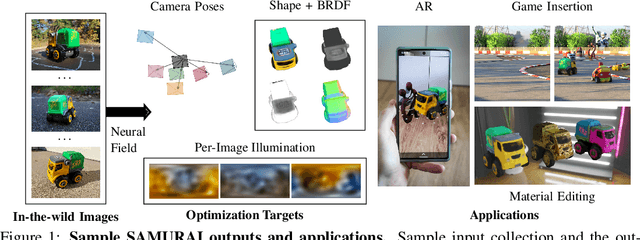


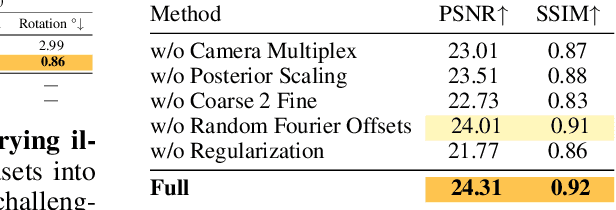
Abstract:Inverse rendering of an object under entirely unknown capture conditions is a fundamental challenge in computer vision and graphics. Neural approaches such as NeRF have achieved photorealistic results on novel view synthesis, but they require known camera poses. Solving this problem with unknown camera poses is highly challenging as it requires joint optimization over shape, radiance, and pose. This problem is exacerbated when the input images are captured in the wild with varying backgrounds and illuminations. Standard pose estimation techniques fail in such image collections in the wild due to very few estimated correspondences across images. Furthermore, NeRF cannot relight a scene under any illumination, as it operates on radiance (the product of reflectance and illumination). We propose a joint optimization framework to estimate the shape, BRDF, and per-image camera pose and illumination. Our method works on in-the-wild online image collections of an object and produces relightable 3D assets for several use-cases such as AR/VR. To our knowledge, our method is the first to tackle this severely unconstrained task with minimal user interaction. Project page: https://markboss.me/publication/2022-samurai/ Video: https://youtu.be/LlYuGDjXp-8
Neural-PIL: Neural Pre-Integrated Lighting for Reflectance Decomposition
Oct 27, 2021


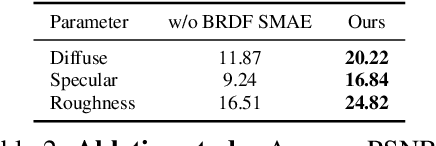
Abstract:Decomposing a scene into its shape, reflectance and illumination is a fundamental problem in computer vision and graphics. Neural approaches such as NeRF have achieved remarkable success in view synthesis, but do not explicitly perform decomposition and instead operate exclusively on radiance (the product of reflectance and illumination). Extensions to NeRF, such as NeRD, can perform decomposition but struggle to accurately recover detailed illumination, thereby significantly limiting realism. We propose a novel reflectance decomposition network that can estimate shape, BRDF, and per-image illumination given a set of object images captured under varying illumination. Our key technique is a novel illumination integration network called Neural-PIL that replaces a costly illumination integral operation in the rendering with a simple network query. In addition, we also learn deep low-dimensional priors on BRDF and illumination representations using novel smooth manifold auto-encoders. Our decompositions can result in considerably better BRDF and light estimates enabling more accurate novel view-synthesis and relighting compared to prior art. Project page: https://markboss.me/publication/2021-neural-pil/
NeRD: Neural Reflectance Decomposition from Image Collections
Dec 08, 2020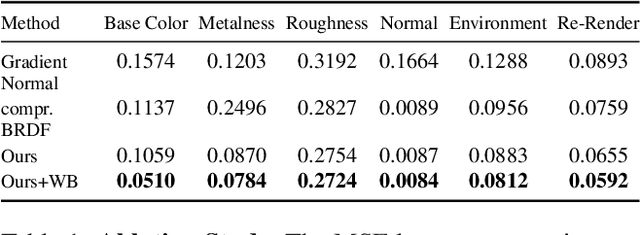
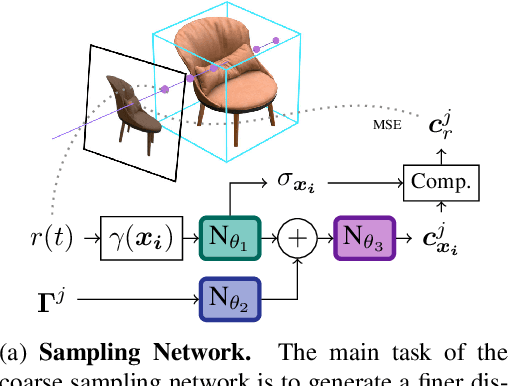
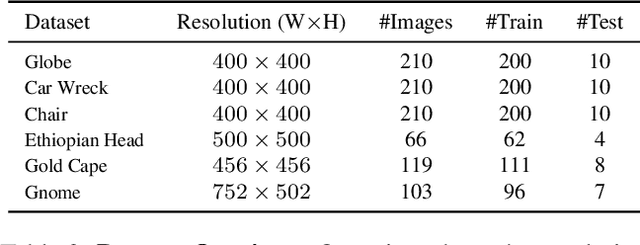
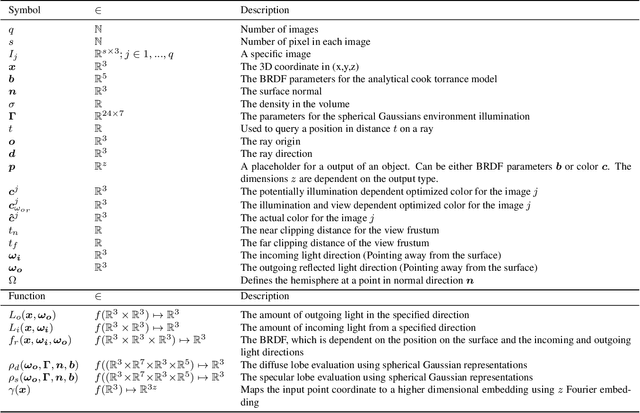
Abstract:Decomposing a scene into its shape, reflectance, and illumination is a challenging but essential problem in computer vision and graphics. This problem is inherently more challenging when the illumination is not a single light source under laboratory conditions but is instead an unconstrained environmental illumination. Though recent work has shown that implicit representations can be used to model the radiance field of an object, these techniques only enable view synthesis and not relighting. Additionally, evaluating these radiance fields is resource and time-intensive. By decomposing a scene into explicit representations, any rendering framework can be leveraged to generate novel views under any illumination in real-time. NeRD is a method that achieves this decomposition by introducing physically-based rendering to neural radiance fields. Even challenging non-Lambertian reflectances, complex geometry, and unknown illumination can be decomposed to high-quality models. The datasets and code is available at the project page: https://markboss.me/publication/2021-nerd/
 Add to Chrome
Add to Chrome Add to Firefox
Add to Firefox Add to Edge
Add to Edge